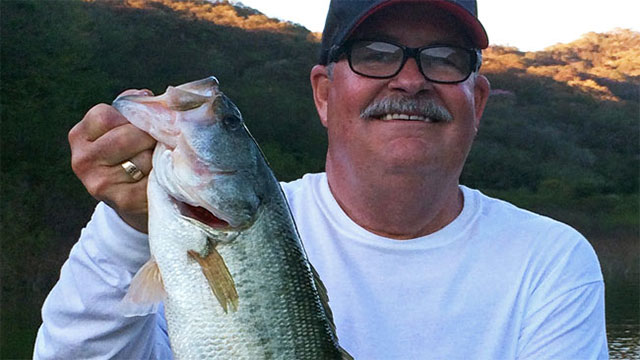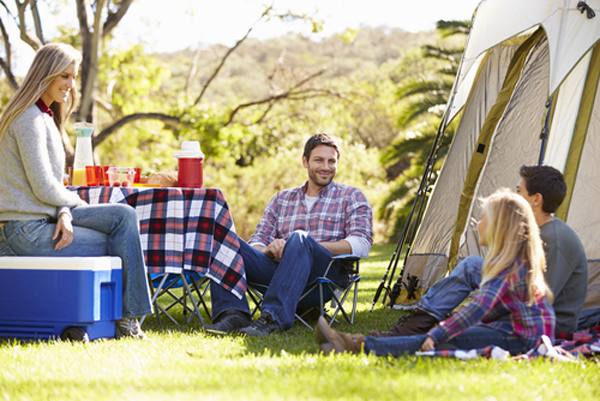SEASON AND LOCATION KEY
•EARLY SPRING
Water Temperature: 40°—55°
Time of Year: February—March in the South; March—April in the North
•SPRING
Water Temperature: 55°—70°
Time of Year: March—April in the South; April—May in the North
POINTS Fan your casts to the points of creek mouths on the main lake and points within the first one-quarter of creek arms with the Rapala SR7 Shad Rap in silver and the Cordell Grappler Shad in pearl cisco. The Shad Rap has a subtle, yet lively, action. You may have to use spinning tackle to cast this lightweight balsa bait, but it's worth the hassle. The plastic Grappler Shad has a similar action, casts better for distance, and (unlike the Shad Rap) has rattles, which could help bass locate it in cloudy water.
GRAVEL AND ROCK Run a Strike King ½-ounce Diamond Shad rattler in honey shad over gravel and rock bottoms near the mouths of creeks. Make regular bottom contact. Sunny banks are generally more productive.
BANKS AND RIPRAP Sweep 45-degree-angle banks and riprap banks with a Bomber BSD5F Suspending Fat Free Fingerling in citrus shad. This bait hovers in place when you pause the retrieve, which gives sluggish bass ample time to respond. If stumps, brush, and other shallow wood exists in any of the above areas, bounce a 3/8-ounce cedar Stanford C-Flat Special in blue-back shad over it.
SUBMERGED GRASS Work over the deep edges of submerged grassbeds, which are just now beginning to grow. In many lakes, grass is present down to depths of 10 to 12 feet, though in especially clear lakes it could be 18 feet or deeper. Tick the top of the vegetation with the fast-sinking Lucky Craft ¾-ounce LV-500 rattler in aurora black and the Bagley B Flat II Coffin Lip in silver with a black back, which dives to 10 feet. Concentrate on points and inside turns.
WOOD COVER Crank a tight-wiggling Luhr-Jensen ¼-ounce Speed Trap in firetiger and a Cordell wide-wobbling 1/3-ounce Big-O in pearl red eye over wood cover. This includes stumps that line creek channels that cut through flats, brush and windfalls along the bank, and next to boat docks.
GRAVEL AND CLAY BANKS Pluck bass from chunk-rock, gravel, riprap, and red-clay banks with a Storm 3/8-ounce Wiggle Wart in phantom brown crayfish and a Norman Deep Baby N in spring crawdad. Both baits have good crayfish actions.
GRASSBEDS Retrieve a ½-ounce Rat-L-Trap in silver with a black back and a Model 5A Bomber in firetiger over submerged grassbeds and along the inside edges of grasslines. Be sure to tick the top of the growth. Mann's 1-Minus in wild shiner, which dives no deeper than 1 foot, is ideal where grass grows up within inches of the surface. Hold the rod tip high to make the 1-Minus create a wake, which often coaxes strikes.
FLOODED BUSHES When the water rises above normal pool, as it often does in the spring, crash a ¾-ounce Rat-L-Trap in red shad through flooded bushes that lie beneath the surface. You 'll need a stiff graphite rod and 50-pound super-braid line for this aggressive tactic.
RULES OF ENGAGEMENT
THE FOLLOWING THREE RULES APPLY FOR CRANKBAIT FISHING IN ANY SEASON:
1. Crankbait fishing is a contact sport. Nudge the bottom, tick submerged vegetation, and bounce crankbaits off wood and rocks.
2. Always vary the retrieve speed and action to find what bass prefer. You might pause after contact, stop and go, rip the bait ahead and kill it, or slowly pull it through cover with the rod tip. Though slow retrieves generally work better in cold water, sometimes frigid bass respond to a fast-moving bait.
3. Use a fiberglass rod for general crankbait fishing. It's less likely to rip treble hooks from a bass' mouth. When fishing in grassbeds, though, a stiff, quick graphite rod is necessary to snap a crankbait cleanly through the vegetation. —M.H.
Mexico Bass Fishing Trip Planning Q & A with MLF Commissioner Don Rucks


Camping Tips : Learn how to Continue being Dried out

Copyright © www.mycheapnfljerseys.com Outdoor sports All Rights Reserved